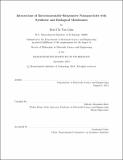| dc.contributor.advisor | Alfredo Alexander-Katz. | en_US |
| dc.contributor.author | Van Lehn, Reid Chi | en_US |
| dc.contributor.other | Massachusetts Institute of Technology. Department of Materials Science and Engineering. | en_US |
| dc.date.accessioned | 2015-01-20T15:29:53Z | |
| dc.date.available | 2015-01-20T15:29:53Z | |
| dc.date.copyright | 2014 | en_US |
| dc.date.issued | 2014 | en_US |
| dc.identifier.uri | http://hdl.handle.net/1721.1/92959 | |
| dc.description | Thesis: Ph. D., Massachusetts Institute of Technology, Department of Materials Science and Engineering, 2014. | en_US |
| dc.description | This electronic version was submitted by the student author. The certified thesis is available in the Institute Archives and Special Collections. | en_US |
| dc.description | Cataloged from student-submitted PDF version of thesis. | en_US |
| dc.description | Includes bibliographical references (pages 259-284). | en_US |
| dc.description.abstract | Nanoparticles (NPs) have recently emerged as a versatile new materials platform for biomedical applications. By tuning their surface functionality, NPs can be engineered to resemble proteins in terms of size, shape, and chemistry, making them ideal for use in vivo. However, a theoretical understanding of how NPs interact with the biological milieu has lagged far behind experiments. In particular, it is critical to gain physical insight into the behavior of NPs at cell surfaces in order to minimize cytotoxic side effects while maximizing NP efficacy. In this thesis, I use several biomolecular simulation techniques to model the interactions of amphiphilic, monolayer-protected NPs with lipid bilayers. This work is motivated by the recent experimental finding that certain gold NPs can penetrate into cells via an unexplained non-endocytic, non-disruptive mechanism. I propose that such a penetration process is possible if the surface properties of the NP can effectively reorganize in the presence of the lipid bilayer. I show that such environmentally-responsive NPs can stably insert into lipid bilayers as a precursor to cell penetration. The thesis divides this study into three Parts. In Part I, I study the thermodynamics of NP-bilayer interactions using both a coarse-grained methodology and a novel implicit bilayer, implicit solvent model. I show that NPs with flexible ligands can fuse with lipid bilayers by "snorkeling" charged end groups out of the bilayer core and into solution. Several experimental studies confirm aspects of this fusion hypothesis and indicate that fusion may be a precursor to cellular internalization. In Part II, I use atomistic molecular dynamics simulations to uncover the kinetic pathway for NP-bilayer fusion. Fusion occurs spontaneously if the NP comes into contact with lipid tail protrusions which occur stochastically over long timescales. In Part III I perform initial studies on cooperative NP behavior. I first show that NPs must be carefully engineering to avoid aggregation in solution prior to contact with the bilayer. I then show that embedded NPs induce membrane deformations similar to those around transmembrane proteins, a finding that implies thats NPs may aggregate due to membrane-mediated forces. On the basis of these results, I propose several examples of cooperative interactions that bear future investigation. The findings of this thesis are a comprehensive study of novel nano-bio interactions that reveal a previously unknown pathway for NP-bilayer fusion. Moreover, the physicochemical similarity between the NPs studied here and both other NP formulations and proteins implies that the results may generalize to a large variety of other synthetic and biological systems. This work will be essential in guiding the design of novel biomaterial systems for bioimaging, biosensing, and drug delivery applications and provides significant physical insight into behavior at the cell surface. | en_US |
| dc.description.statementofresponsibility | by Reid Chi Van Lehn. | en_US |
| dc.format.extent | 284 pages | en_US |
| dc.language.iso | eng | en_US |
| dc.publisher | Massachusetts Institute of Technology | en_US |
| dc.rights | M.I.T. theses are protected by copyright. They may be viewed from this source for any purpose, but reproduction or distribution in any format is prohibited without written permission. See provided URL for inquiries about permission. | en_US |
| dc.rights.uri | http://dspace.mit.edu/handle/1721.1/7582 | en_US |
| dc.subject | Materials Science and Engineering. | en_US |
| dc.title | Interactions of environmentally-responsive nanoparticles with synthetic and biological membranes | en_US |
| dc.type | Thesis | en_US |
| dc.description.degree | Ph. D. | en_US |
| dc.contributor.department | Massachusetts Institute of Technology. Department of Materials Science and Engineering | |
| dc.identifier.oclc | 899266905 | en_US |
